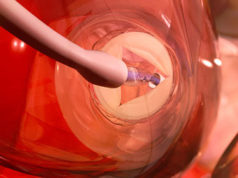St Jude Medical announced on 21 September 2009 the first use of the PressureWire Aeris technology, an interventional tool which measures fractional flow reserve (FFR) to evaluate the severity of blood flow blockages in the arteries. This first-to-market technology helps interventional cardiologists better determine the ideal treatment option for their patients during coronary interventions, such as stent procedures. The first procedures in the US were performed by Mark Zolnick at Christus St Vincent Regional Medical Center in Santa Fe.
The PressureWire Aeris is a first-of-its-kind wireless FFR system which requires no additional equipment or cabling in the cardiac catheterisation laboratory. Using the PressureWire Aeris technology, interventional cardiologists can accurately assess the severity of lesions. Having this information available prior to placement of coronary stents helps physicians better determine which specific lesion or lesions are responsible for a patient’s ischaemia.
“Using the PressureWire Aeris helped me determine instantly and with certainty the best course of treatment for my patients. In the first case, I was able to decide that the narrowing of the arteries was not severe enough to warrant stenting, and in the next I used the FFR technology to confirm the ideal stent placement,” said Mark Zolnick, a cardiologist at New Mexico Heart Institute. “The PressureWire Aeris is extremely easy to use, reduces material costs and improves patient outcomes. From both a clinical and cost effectiveness perspective, I believe that this technology should be a standard of care.”
The landmark FAME trial, which compared FFR-guided treatment using St Jude Medical PressureWire technology to stenting with angiography alone, found that in addition to saving about 11% in unnecessary material cost, instances of major adverse cardiovascular events, such as death, myocardial infarction and repeat revascularisation, are reduced by 28%. The study also found that routine measurement of FFR requires no additional procedure time.
The PressureWire Aeris system integrates FFR technology directly into the Mac-Lab Hemodynamic Recording System to immediately display, measure and save FFR data. With FFR results integrated into a patient’s existing study record, this is the only system on the market where the severity of coronary lesions is documented together with other procedural data and angiographic imagery.
The Mac-Lab FFR upgrade, which is available for the XT and XTi Mac-Lab configurations, combines existing catheterisation lab infrastructure, including screens, input modules and controls, with the PressureWire Aeris technology to form a seamlessly integrated FFR measurement system, resulting in improved workflow.
The wireless technology of the PressureWire Aeris also eliminates cables crossing the sterile field, reducing variables and making the entire procedure faster and easier. Physicians can remove the device’s handle and insert a stent delivery system directly over the PressureWire Aeris, eliminating the time and cost of using an additional, traditional guidewire.










